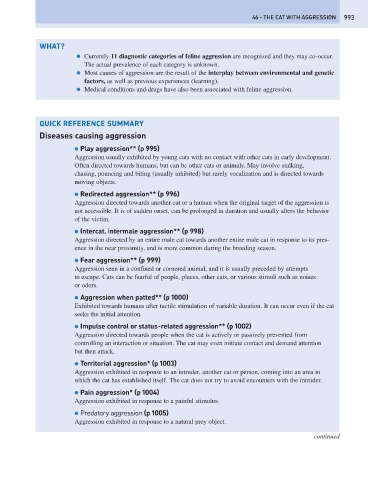Page 1001 - Problem-Based Feline Medicine
P. 1001
46 – THE CAT WITH AGGRESSION 993
WHAT?
● Currently 11 diagnostic categories of feline aggression are recognized and they may co-occur.
The actual prevalence of each category is unknown.
● Most causes of aggression are the result of the interplay between environmental and genetic
factors, as well as previous experiences (learning).
● Medical conditions and drugs have also been associated with feline aggression.
QUICK REFERENCE SUMMARY
Diseases causing aggression
● Play aggression** (p 995)
Aggression usually exhibited by young cats with no contact with other cats in early development.
Often directed towards humans, but can be other cats or animals. May involve stalking,
chasing, pouncing and biting (usually inhibited) but rarely vocalization and is directed towards
moving objects.
● Redirected aggression** (p 996)
Aggression directed towards another cat or a human when the original target of the aggression is
not accessible. It is of sudden onset, can be prolonged in duration and usually alters the behavior
of the victim.
● Intercat, intermale aggression** (p 998)
Aggression directed by an entire male cat towards another entire male cat in response to its pres-
ence in the near proximity, and is more common during the breeding season.
● Fear aggression** (p 999)
Aggression seen in a confined or cornered animal, and it is usually preceded by attempts
to escape. Cats can be fearful of people, places, other cats, or various stimuli such as noises
or odors.
● Aggression when patted** (p 1000)
Exhibited towards humans after tactile stimulation of variable duration. It can occur even if the cat
seeks the initial attention.
● Impulse control or status-related aggression** (p 1002)
Aggression directed towards people when the cat is actively or passively prevented from
controlling an interaction or situation. The cat may even initiate contact and demand attention
but then attack.
● Territorial aggression* (p 1003)
Aggression exhibited in response to an intruder, another cat or person, coming into an area in
which the cat has established itself. The cat does not try to avoid encounters with the intruder.
● Pain aggression* (p 1004)
Aggression exhibited in response to a painful stimulus.
● Predatory aggression (p 1005)
Aggression exhibited in response to a natural prey object.
continued

